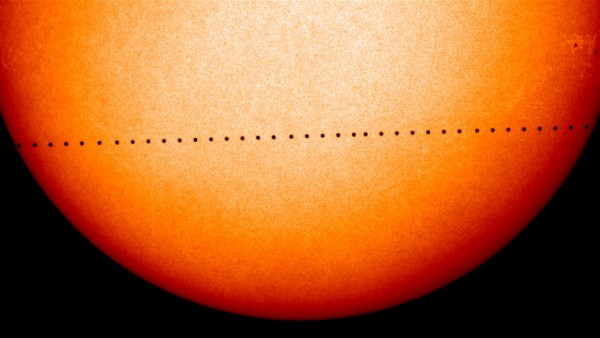By Ana Verayo, | May 04, 2016

The 2016 Mercury transit (depicted conceptually here) will occur between about 7:12 a.m. and 2:42 p.m. EDT on May 9.
In this extremely rare cosmic event, Mercury will be passing directly in front of the Sun and Earth on May 9, where astronomers say that this phenomenon only happens 13 times for every 100 years.
Like Us on Facebook
For those who are wondering who can view and where will this Mercury transit will occur, this cosmic event can be observed for most parts of the globe from western Europe, most parts of South America, eastern region of North America and the western part of north and west Africa. Unfortunately, this rare Mercury activity will not become visible in parts of eastern Asia including Japan where the Antarctic region and the entire Oceania will not be able to see any of Mercury.
This Mercury transit only occurs when the orbital plane of our planet makes an intersection with Mercury's orbit. This occurrence transpires usually during early May or November, according to NASA's Goddard Space Flight Center. Apart from Mercury, Venus also transits the sun twice every century.
This May 9 transit will be divided into five stages or periods known as contacts. The first contact, Contact I, will happen at 7:12:19 EDT when the planet passes through the solar limb. Contact II enters next at 7:15:31 EDT where Mercury will now be tangent to the interior of the sun as it spans across the solar disk. During Contact III at 2:39:14 EDT, the planet will now reach the other side of the solar limb which will continue to exit the sun's internal tangent during Contact IV 2:42:26 EDT. The whole transit process will take 7.5 hours in total.
For amateurs, a telescope that is equipped with a 50X magnification should be enough since Mercury is a tiny planet. Apart from this, solar filters should also be fitted to prevent ocular damage and eye strain. The last Mercury transit occurred in 2006.
Those who cannot witness this rare Mercury transit, there will be a live coverage online via Slooh or the VirtualTelescope. NASA will also host a public viewing event of Mercury via NASA Television, streaming live on NASA TV.
-
Use of Coronavirus Pandemic Drones Raises Privacy Concerns: Drones Spread Fear, Local Officials Say

-
Coronavirus Hampers The Delivery Of Lockheed Martin F-35 Stealth Fighters For 2020

-
Instagram Speeds Up Plans to Add Account Memorialization Feature Due to COVID-19 Deaths

-
NASA: Perseverance Plans to Bring 'Mars Rock' to Earth in 2031

-
600 Dead And 3,000 In The Hospital as Iranians Believed Drinking High-Concentrations of Alcohol Can Cure The Coronavirus

-
600 Dead And 3,000 In The Hospital as Iranians Believed Drinking High-Concentrations of Alcohol Can Cure The Coronavirus

-
COVID-19: Doctors, Nurses Use Virtual Reality to Learn New Skills in Treating Coronavirus Patients







